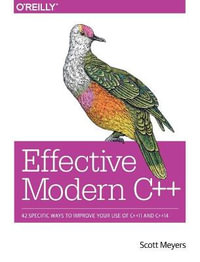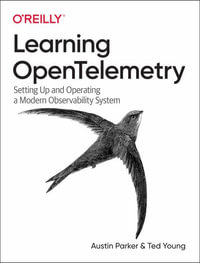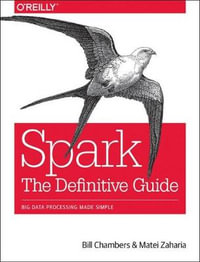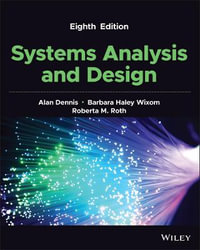
At a Glance
696 Pages
23.39 x 15.6 x 3.81
Hardcover
$111.38
or 4 interest-free payments of $27.84 with
orAims to ship in 7 to 10 business days
| Preface | p. xv |
| Introductory Elements: Dependability Issues | p. 1 |
| Quality | p. 1 |
| Quality Needs of Computer Systems | p. 1 |
| Quality Attributes | p. 2 |
| Dependability | p. 3 |
| Product Failures and their Consequences | p. 3 |
| Failure Causes | p. 4 |
| Taking Faults into Account | p. 7 |
| Definitions of Dependability | p. 9 |
| Means of Dependability | p. 10 |
| Evolution | p. 10 |
| Means | p. 13 |
| Summary | p. 13 |
| Destructive Mechanisms | p. 15 |
| General Context | p. 17 |
| Application Context | p. 17 |
| Life Cycle | p. 21 |
| Principles | p. 21 |
| Specification | p. 22 |
| Design | p. 24 |
| Production | p. 28 |
| Operation | p. 29 |
| Product Model | p. 29 |
| Product Structure and Functioning | p. 30 |
| Hierarchy | p. 31 |
| Examples | p. 32 |
| Refinement Process and Primitive Components | p. 33 |
| Logical Part of a Drinks Distributor | p. 34 |
| Specifications | p. 35 |
| Design | p. 36 |
| Production | p. 38 |
| Operation | p. 38 |
| Failures and Faults | p. 39 |
| Failures | p. 39 |
| Definition | p. 39 |
| Characterization of Failures | p. 42 |
| Faults | p. 44 |
| Difficulties in Identifying the Causes of a Failure | p. 44 |
| Fault Characterization | p. 45 |
| Fault Origin | p. 46 |
| Nature of the Fault | p. 48 |
| Faults Occurring in the Life Cycle | p. 51 |
| Specification and Design Faults | p. 52 |
| Production Faults | p. 56 |
| Operational Faults | p. 58 |
| Examples of Functional Faults Altering a Drinks Distributor | p. 60 |
| Description of the Product | p. 60 |
| Faults Due to Functional Specifications | p. 61 |
| Faults Due to Technological Constraints | p. 61 |
| Design Faults | p. 62 |
| Interests and Limits of Fault Classes | p. 63 |
| Simplified Classification | p. 63 |
| Limitations of the Classification | p. 65 |
| Protection Against Faults and their Effects | p. 65 |
| Exercises | p. 66 |
| Faults and their Effects | p. 69 |
| Internal Effects | p. 69 |
| Fault | p. 69 |
| Error | p. 71 |
| Error Propagation | p. 73 |
| Latency | p. 75 |
| External Effects: Consequences | p. 77 |
| External Consequences of Faults | p. 77 |
| Inertia of the Functional Environment | p. 80 |
| Completeness and Compatibility | p. 80 |
| Influence of the Functional Environment: Emergence | p. 82 |
| Conclusion on the Effects of Faults | p. 83 |
| Exercises | p. 85 |
| Fault and Error Models | p. 89 |
| Definitions | p. 89 |
| Structural and Behavioral Properties | p. 89 |
| Structural Properties | p. 90 |
| Behavioral Properties | p. 91 |
| Significant Fault and Error Models | p. 92 |
| Faults and Errors at Different Representation Levels | p. 92 |
| Hardware Fault/Error Models | p. 94 |
| Software Fault and Error Models | p. 101 |
| Fault and Error Model Assessment | p. 105 |
| Assessment Criteria | p. 105 |
| Relations Between Fault/Error Models and Failures | p. 107 |
| Analysis of Two Simple Examples | p. 109 |
| First example: an Hardware Full Adder | p. 109 |
| Second Example: a Software Average Function | p. 111 |
| Exercises | p. 115 |
| Protective Mechanisms | p. 119 |
| Towards the Mastering of Faults and their Effects | p. 121 |
| Three Approaches | p. 121 |
| Fault Prevention | p. 123 |
| During the Specification | p. 123 |
| During the Design | p. 124 |
| During the Production | p. 124 |
| During the Operation | p. 125 |
| Fault Removal | p. 127 |
| General Notions | p. 127 |
| During Specification and Design | p. 129 |
| During the Production | p. 133 |
| During the Operation | p. 134 |
| Fault Tolerance | p. 135 |
| Failure Prevention by Masking | p. 136 |
| Error Detection and Correction | p. 136 |
| Fail-Safe Techniques | p. 137 |
| Resulting Fault Tolerance Classes | p. 138 |
| Dependability Means and Assessment | p. 138 |
| Conclusion | p. 140 |
| Dependability Assessment | p. 141 |
| Quantitative and Qualitative Assessment | p. 141 |
| Quantitative Assessment | p. 141 |
| Qualitative Assessment | p. 143 |
| Synthesis | p. 143 |
| Reliability | p. 145 |
| General Characteristics of the Reliability of Electronic Systems | p. 145 |
| Reliability Models | p. 146 |
| Failure Rate Estimation | p. 148 |
| Reliability Evolution | p. 148 |
| Testability | p. 149 |
| Maintainability | p. 150 |
| Maintenance | p. 150 |
| Maintainability | p. 152 |
| Reliability and Maintainability | p. 153 |
| Availability | p. 154 |
| Safety | p. 155 |
| Security | p. 157 |
| Synthesis of the Main Criteria | p. 157 |
| Quantitative Analysis Tools at System Level | p. 159 |
| Fault Simulation | p. 159 |
| Reliability Block Diagrams | p. 160 |
| Non-Deterministic State Graph Models | p. 162 |
| Inductive Qualitative Assessment: Failure Mode and Effect Analysis | p. 164 |
| Principles | p. 164 |
| Means | p. 166 |
| FMECA | p. 167 |
| Deductive Qualitative Assessment: Fault Tree Method | p. 168 |
| Principles | p. 168 |
| Software Example | p. 169 |
| Use of the FTM | p. 171 |
| Exercises | p. 171 |
| Redundancy | p. 175 |
| Functional and Structural Redundancy | p. 176 |
| Linguistic Redundancy | p. 176 |
| Redundancy of Computer Systems | p. 177 |
| Functional Redundancy | p. 179 |
| Static Functional Domains | p. 180 |
| Dynamic Functional Domains | p. 182 |
| Generalization of Functional Redundancy | p. 185 |
| Redundancy and Module Composition | p. 186 |
| Structural Redundancy | p. 187 |
| Definition and Illustration | p. 187 |
| Active and Passive Redundancy | p. 188 |
| Separable Redundancy | p. 193 |
| Summary of the Various Redundancy Forms | p. 195 |
| Exercises | p. 195 |
| Fault Avoidance Means | p. 199 |
| Avoidance of Functional Faults During Specification | p. 201 |
| Introduction | p. 201 |
| Specification Phase | p. 201 |
| Validation and Verification | p. 202 |
| Fault Prevention During the Requirement Expression | p. 204 |
| Introduction | p. 204 |
| Help in the Capturing of Needs | p. 204 |
| Expression Aid | p. 205 |
| Evaluation of a Method | p. 207 |
| Fault Avoidance During the Specification Phase | p. 209 |
| Fault Prevention: Valid Method | p. 209 |
| Fault Removal: Verification of the Specifications | p. 211 |
| Review Techniques | p. 214 |
| Principles | p. 214 |
| Walkthrough | p. 215 |
| Inspection | p. 215 |
| Exercise | p. 217 |
| Avoidance of Functional Faults During Design | p. 219 |
| Principles | p. 219 |
| Prevention by Design Model Choice | p. 222 |
| Prevention by Design Process Choice | p. 223 |
| General Considerations | p. 223 |
| Design Guide | p. 224 |
| Expression Guide | p. 225 |
| Fault Removal | p. 229 |
| Verification with the Specifications | p. 229 |
| Fault Removal without Specifications | p. 238 |
| Functional Test | p. 240 |
| Input Sequence | p. 240 |
| Output Sequence | p. 243 |
| Functional Diagnosis | p. 245 |
| Analysis of an Arithmetic Unit | p. 247 |
| Formal Proof Methods | p. 248 |
| Inductive Approach and Symbolic Execution | p. 248 |
| Deductive Approach and FTM | p. 251 |
| Exercises | p. 253 |
| Prevention of Technological Faults | p. 257 |
| Parameters of the Prevention of Technological Faults | p. 257 |
| Hardware Technology | p. 258 |
| Software Technology | p. 258 |
| Prevention of Technological Faults | p. 260 |
| Action on the Product | p. 261 |
| Hardware Technology | p. 261 |
| Software Technology | p. 265 |
| Action on the Environment | p. 272 |
| Hardware Technology | p. 272 |
| Software Technology | p. 273 |
| Exercises | p. 276 |
| Removal of Technological Faults | p. 279 |
| Off-Line Testing | p. 279 |
| Context of Off-Line Testing | p. 280 |
| Different Kinds of Tests and Testers | p. 281 |
| Logical Testing | p. 288 |
| Logical Testers | p. 288 |
| Test Parameters | p. 291 |
| Production Testing | p. 292 |
| Maintenance Testing | p. 296 |
| Principles of Logical Test Generation | p. 302 |
| Logical Testing | p. 302 |
| Determination of Input Vectors Testing a Fault | p. 307 |
| Fault Grading | p. 307 |
| Test Pattern Generation of Combinational Systems | p. 314 |
| Test of Sequential Systems | p. 316 |
| Exercises | p. 320 |
| Structural Testing Methods | p. 323 |
| Generation of Logical Test by a Gate Level Structural Approach | p. 323 |
| Test Generation for a Given Error | p. 325 |
| Principles of the Method | p. 325 |
| Activation and Backward Propagation | p. 326 |
| Forward Propagation | p. 327 |
| Justification | p. 329 |
| Complete Study of a Small Circuit | p. 329 |
| Test of Structured Circuits | p. 332 |
| Determination of the Faults/Errors Detected by a Given Test Vector | p. 333 |
| Principles of the Method | p. 333 |
| Study of a Small Circuit | p. 335 |
| Diagnosis of a Test Sequence | p. 336 |
| General Problem of the Diagnosis | p. 336 |
| Study of a Small Circuit | p. 337 |
| Influence of Passive Redundancy on Detection and Diagnosis | p. 339 |
| Detection Test without Error Model. Application to Software | p. 340 |
| The Problem of Structural Test without Error Model | p. 340 |
| Statement Test | p. 342 |
| Branch & Path Test | p. 343 |
| Condition & Decision Test | p. 345 |
| Finite State Machine Identification | p. 346 |
| Diagnosis without Fault Models | p. 346 |
| Principles | p. 346 |
| Highlight the Erroneous Situations | p. 347 |
| Elaborate the Hypotheses | p. 349 |
| Confirm the Hypotheses | p. 350 |
| Verify the Hypotheses | p. 350 |
| Mutation Test Methods | p. 351 |
| Principles and Pertinence of Mutation Methods | p. 351 |
| Mutation Testing Technique | p. 352 |
| Exercises | p. 354 |
| Design For Testability | p. 361 |
| Introduction | p. 361 |
| Test Complexity | p. 361 |
| General Principles of Design For Testability | p. 362 |
| Ad Hoc Approach to DFT | p. 367 |
| Guidelines | p. 367 |
| Instrumentation: Data Recording | p. 373 |
| Exception Mechanisms: Error Propagation | p. 374 |
| Design of Systems Having Short Test Sequences | p. 377 |
| Illustration on Electronic Products | p. 377 |
| Illustration on Software Applications | p. 379 |
| Built-In Test (BIT) | p. 380 |
| Introduction | p. 380 |
| The FIT PLA | p. 380 |
| Scan Design and LSSD | p. 383 |
| Boundary Scan | p. 385 |
| Discussion about BIT Evolution | p. 387 |
| Built-In Self-Test (BIST) | p. 388 |
| Principles | p. 388 |
| Test Sequence Generation and Signature Analysis | p. 389 |
| Towards On-Line Testing | p. 392 |
| To Place the Tester in the Application Site | p. 392 |
| In-situ Maintenance Operation | p. 392 |
| Integration of the Tester to the Product's Activity | p. 393 |
| Exercises | p. 393 |
| Fault Tolerance Means | p. 397 |
| Error Detecting and Correcting Codes | p. 399 |
| General Context | p. 399 |
| Error Model | p. 399 |
| Redundant Coding | p. 402 |
| Application to Error Detection and Correction | p. 403 |
| Limitations of our Study | p. 404 |
| Definitions | p. 405 |
| Separable and Non-Separable Codes | p. 405 |
| Hamming Distance | p. 406 |
| Redundancy and Efficiency | p. 408 |
| Parity Check Codes | p. 409 |
| Single Parity Code | p. 409 |
| Multiple Parity Codes | p. 409 |
| Unidirectional Codes | p. 416 |
| M-out-of-n Codes | p. 417 |
| Two-Rail Codes | p. 418 |
| Berger Codes | p. 418 |
| Arithmetic Codes | p. 419 |
| Limitations of the Hamming Distance | p. 419 |
| Residual Codes | p. 420 |
| Application of EDC Codes to Different Classes of Systems | p. 422 |
| Exercises | p. 423 |
| On-Line Testing | p. 427 |
| Two Approaches of On-Line Testing | p. 427 |
| Discontinuous Testing | p. 428 |
| External Tester | p. 428 |
| Test Performed by One of the Regulators | p. 430 |
| Test Distributed Between the Regulators | p. 430 |
| Precautions | p. 432 |
| Continuous Testing: Self-Testing | p. 433 |
| Principles | p. 433 |
| Use of Functional Redundancy | p. 436 |
| Use of Structural Redundancy | p. 441 |
| Exercises | p. 447 |
| Fail-Safe Systems | p. 451 |
| Risk and Safety | p. 452 |
| Seriousness Classes | p. 452 |
| Risk and Safety Classes | p. 453 |
| Fail-Safe Systems | p. 456 |
| Fail-Safe Techniques | p. 457 |
| Intrinsic Safety | p. 457 |
| Safety by Structural Redundancy | p. 459 |
| Self-Testing Systems and Fail-Safe Systems | p. 465 |
| Fail-Safe Applications | p. 466 |
| Exercises | p. 467 |
| Fault-Tolerant Systems | p. 469 |
| Introduction | p. 469 |
| Aims | p. 469 |
| From Error Detection Towards Fault Tolerance | p. 470 |
| N-Versions | p. 472 |
| Principles | p. 472 |
| Realization of the Duplicates and the Voter | p. 473 |
| Performance Analysis | p. 475 |
| Backward Recovery | p. 476 |
| Principles and Use | p. 476 |
| Recovery Cache | p. 478 |
| Recovery Points | p. 479 |
| Forward Recovery | p. 482 |
| Principles | p. 482 |
| Recovery Blocks | p. 482 |
| Termination Mode | p. 483 |
| Comparison | p. 485 |
| Similarities | p. 485 |
| Differences | p. 487 |
| Use of Multiple Techniques | p. 490 |
| Impact on the Design | p. 493 |
| Some Application Domains | p. 496 |
| Watchdog and Reset | p. 496 |
| Avionics Systems | p. 496 |
| Data Storage | p. 498 |
| Data Transmission | p. 503 |
| Exercises | p. 508 |
| Conclusions | p. 511 |
| Needs and Impairments | p. 512 |
| Dependability Needs | p. 512 |
| Dependability Impairments | p. 513 |
| Protective Means | p. 516 |
| Fault Prevention | p. 516 |
| Fault Removal | p. 517 |
| Fault Tolerance | p. 519 |
| Dependability Assessment | p. 520 |
| Quantitative Approaches | p. 520 |
| Qualitative Approaches | p. 524 |
| Choice of Methods | p. 525 |
| Error Detecting and Correcting Codes | p. 527 |
| Reliability Block Diagrams | p. 529 |
| Testing Features of a Microprocessor | p. 535 |
| Study of a Software Product | p. 539 |
| Answer to the Exercises | p. 543 |
| Glossary | p. 605 |
| References | p. 651 |
| Index | p. 657 |
| Table of Contents provided by Ingram. All Rights Reserved. |
ISBN: 9781402004377
ISBN-10: 1402004370
Published: 28th February 2002
Format: Hardcover
Language: English
Number of Pages: 696
Audience: Professional and Scholarly
Publisher: Springer Nature B.V.
Country of Publication: US
Dimensions (cm): 23.39 x 15.6 x 3.81
Weight (kg): 1.37
Shipping
| Standard Shipping | Express Shipping | |
|---|---|---|
| Metro postcodes: | $9.99 | $14.95 |
| Regional postcodes: | $9.99 | $14.95 |
| Rural postcodes: | $9.99 | $14.95 |
How to return your order
At Booktopia, we offer hassle-free returns in accordance with our returns policy. If you wish to return an item, please get in touch with Booktopia Customer Care.
Additional postage charges may be applicable.
Defective items
If there is a problem with any of the items received for your order then the Booktopia Customer Care team is ready to assist you.
For more info please visit our Help Centre.
You Can Find This Book In

Cloud Native Application Protection Platforms
A Guide to CNAPPs and the Foundations of Comprehensive Cloud Security
Paperback
RRP $125.50
$60.90
OFF
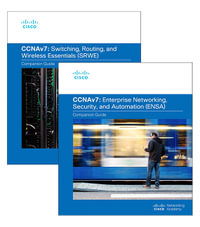
Enterprise Networking, Security, and Automation Companion Guide (CCNAv7) + Switching, Routing, and Wireless Essentials Companion Guide (CCNAv7)
Book with Other Items
RRP $189.95
$148.50
OFF
This product is categorised by
- Non-FictionComputing & I.T.Computer ScienceSystems Analysis & Design
- Non-FictionComputing & I.T.Computer ScienceComputer Architecture & Logic Design
- Non-FictionComputing & I.T.Computer Programming & Software Development
- Non-FictionComputing & I.T.DatabasesData Capture & Analysis
- Non-FictionComputing & I.T.Graphical & Digital Media ApplicationsComputer-Aided Design CAD
